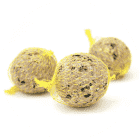Varied Thrush
A species of Varied Thrushes Scientific name : Ixoreus naevius Genus : Varied Thrushes
Varied Thrush, A species of Varied Thrushes
Botanical name: Ixoreus naevius
Genus: Varied Thrushes
Content
Description People often ask General Info
 Photo By Francesco Veronesi , used under CC-BY-SA-2.0 /Cropped and compressed from original
Photo By Francesco Veronesi , used under CC-BY-SA-2.0 /Cropped and compressed from original Description
The varied thrush is a fairly large thrush species. It can range from 20 to 26 cm (7.9 to 10.2 in) in length and can span 34 to 42 cm (13 to 17 in) across the wings. Body mass can vary from 65 to 100 g (2.3 to 3.5 oz). Among standard measurements, the wing chord is 11.8 to 13.6 cm (4.6 to 5.4 in), the bill is 1.8 to 2.3 cm (0.71 to 0.91 in) and the tarsus is 2.9 to 3.3 cm (1.1 to 1.3 in). It is similar in size to the widespread American robin, though the varied is on average shorter with a heavier, more robust build. In general, varied thrushes feature intense orange and black feathers. Adult males exhibit medium orange with a curved gray pattern at the breasts and throats, with grayish-blue tail ends, scruffs, and crowns. They also possess a tufted supraloral stripe and streaks of dark colors on its flight feathers. Its bill is also achromatic, but tan near the bottom of the lower jaw. Its legs are often tawny or dark brown. Females' markings are not as well-defined, with olive-browns and grays, brown hind feathers, and indiscernible gray-brown plumage near the breasts. Young varied thrushes are generally brown, though their stomach feathers are white, and initially harbor two orange stripes at the covert feathers. Eggs are generally 3-4 per nest, but sometimes 2–5. Pale blue, lightly dotted with brown. Incubation is by female, probably about 2 weeks. Young: Both parents feed nestlings. Development of young and age at which they leave the nest are not well known. Probably 2 broods per year. There is an extremely rare variant of this species in which all the orange in the plumage is replaced by white. A very rare British vagrant in 1982 was of this type, leading to speculation that whatever mutation causes the colour variation also affects the navigational abilities of this thrush. There have been only five recorded sightings since 1921. 
Size
20 - 26 cm
Colors
Brown
Black
Gray
Blue
Orange
Life Expectancy
5.6 years
Nest Placement
Tree
Clutch Size
1 - 6 eggs
Incubation Period
1 - 2 broods
Number of Broods
12 days
Nestling Period
13 - 15 days
Feeding Habits
Varied Thrush's diet changes with seasons, consuming insects and arthropods in breeding season and berries, nuts in fall/winter. They forage, moving leaf litter to uncover prey or forming flocks near fruit sources. They eat various berries, acorns, and occasionally seeds.
Habitat
Varied Thrush primarily resides in moist coniferous forests at higher elevations, featuring dense stands of trees like redwoods and spruces. They favor wet climates within broadleaf and mixed woodlands. During the non-breeding season, they occupy more varied landscapes including towns and lakeshores, while their larger geographical range encompasses the Pacific Northwest, extending eastward in winter.
Nest Behavior
The female varied Thrush selects the nest site and constructs it with various materials. The timing of nest building and egg-laying is not specified. Parental care involves creating a dense, layered nest for the eggs and young, but the specifics of egg incubation and care for the hatchlings are not detailed.
Nest Characteristics
Varied Thrush typically builds nests in the understory of mature forests, often near or on old nests. Located about 10 feet off the ground, close to conifer trunks, the poorly concealed nests comprise an outer layer of twigs from trees like fir or spruce, a hardened middle layer of mixed materials, and a soft lining, measuring roughly 4 inches across and 2 inches deep.
Dite type
Insectivorous
People often ask
General Info
Feeding Habits
Bird food type

Hulled Sunflower Seeds

Suet

Fruit

Mealworms
Bird Feeder Type

Platform

Ground
Sounds
Call
Recording location: United States
Call
Recording location: United States
Song
Recording location: United States
Song
Recording location: United States
Behavior
Varied Thrush exemplifies a distinct lifestyle, marked by their ground foraging habits, interspersed with strategic perches for singing or relocating. The males precede females to breeding grounds for territorial songs. Their interactions include elaborate threat displays such as tail cocking, wing lowering, and in more aggressive encounters, bill locking or dive swoops through dense flora. Notably, males also guard feeding areas in winter, with females consequently seeking alternate sites. Monogamy is observed, though pair bonding duration remains uncertain.
Distribution Area
The varied thrush breeds in western North America from Alaska to northern California. It is migratory, with northern breeders moving south within or somewhat beyond the breeding range. Other populations may only move altitudinally. This species is an improbable transatlantic vagrant, but there is an accepted western European record in Great Britain in 1982. Nests in Alaska, Yukon Territory, and mountains in British Columbia, Washington, and Oregon. Prefers moist conifer forest. Most common in dense, older conifer forests in high elevations. Moves to lower elevations during the winter where it is often seen in towns and orchards and thickets, or migrates to California. Seen in flocks during winter of up to 20 birds. It is well known for individual birds to fly eastward in winter, showing up in just about any state, then returning to the west coast for breeding. 
Scientific Classification
Phylum
Chordates Class
Birds Order
Perching birds Family
Thrushes Genus
Varied Thrushes Species
Varied Thrush